Théâtre Libre Programs: Henri-Gabriel Ibels
The Théâtre Libre was created in 1887 by André Antoine (1858-1943). The theater lasted through April 1896, but only through spring of 1894 under the direction of Antoine. The theater’s first performance took place on March 30th on the Passage de l’Elysée des Beaux-Arts, in the 18e arrondissement, just off the Place Pigalle. Today the street is known as rue André Antoine, in honor of the mark left on French theater by its founder. A second performance took place on May 30th. From the start the theater was associated with cutting edge tendencies and performed works by important avant-garde authors such as Emile Zola and Oscar Méténier. At the second performance famous men of the arts were already in attendance: the renowned actor Coquelin cadet, the poet Jean Richepin, painters Pierre Puvis de Chavannes and Auguste Rodin, and even the owner of the Chat Noir cabaret Rodolphe Salis. The latter even invited Antoine to perform En Famille by Méténier at the Chat Noir, which Antoine decline, despite being short of financial resources to run his shows.
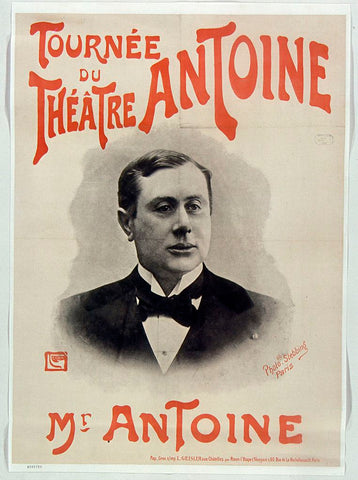
The Théâtre Libre was a subscription-only outfit. The reason for this was Antoine’s desire to perform mostly naturalist plays, and eventually symbolist ones as well. This repertoire included all manner of subjects which official censure frowned upon. Had his theater been “public”, they could have shut him down. Being a private subscription organization, this risk was averted. While France had embraced realistic, naturalistic and symbolist tendencies in other art forms, like writing and painting, the theater scene was still very much looking backwards. Actors were nearly all trained by the conservative Conservatoire de musique et de déclamation. And only actors in the mold of their traditional teachers were allowed to rise to stardom.
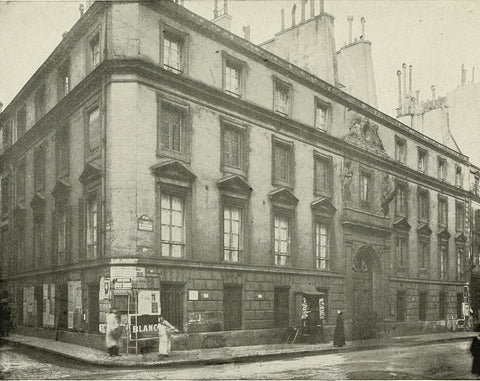
Conservatoire de musique et de déclamation
As Patricia Eckert Boyer puts it in her seminal research published in an exhibition catalogue of the National Gallery of Art in 1998: “[Antoine] introduced [in his theater] subjects that Edouard Manet had developed in painting and Emile Zola in literature for the previous twenty years: the lives of the poor, the working classes, the sordid underside of belle-époque society.”.
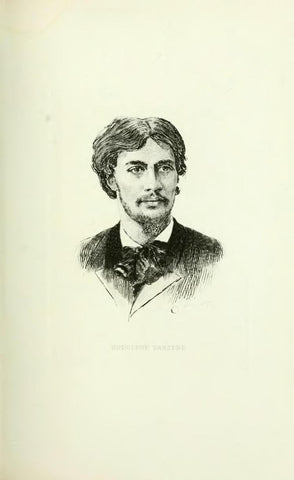
Rodolphe Darzens
The first full season of the Théâtre started in October 1887. By then Antoine had installed a poet named Rodolphe Darzens (1865-1938) as secretary. From their correspondence it is clear that theirs was a deep mutual appreciation; and Darzens quickly influenced the theater much more than simply by keeping the books in order. He was a graduate of the Lycée Condorcet where many Parisian artists and men of letters of the time studied: the historian Camille Block, the actor Lungé Poé (born Aurélien Lungé), painters Edouard Vuillard, Pierre Bonnard… He connected with many of these men while studying, but also afterwards, being introduced to avant-garde artists in Belgium and Russia, where he lived periodically. His family had lived in Moscow for a time and the young man spoke Russian. All these connections clearly contributed greatly to the success of the Théâtre Libre. From the onset important avant-garde authors, both French and foreign, gave plays to the theater. Many of the foreign plays were being performed in France for the first time at the Théâtre Libre.

Alexandre Charpentier: plaque of Maximilen Luce
During the 1887-1888 season Alexandre Charpentier, who was a talented sculptor, created medallion portraits of many of the artists who frequented the theater. While there had not been an association between the theater and the fine arts, this project seems to have brought about a collaboration which helped spread the budding fame of these performances. Starting in the fall of 1888 the playbill of each play was illustrated by an artist. Among the first to illustrate these programs were Adolphe Léon Willette, Paul Signac, Jean-François Raffaëlli, Henri Rivière, Georges Auriol and Alexandre Charpentier. These ephemera were an instant success and immediately became collectibles. The artists’ fame was augmented by their association with avant-garde literature, and vice versa.
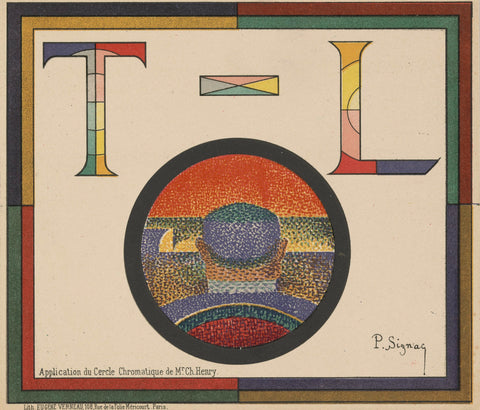
Paul Signac: Cercle Chromatique program for the Théâtre Libre
This practice became a habit and many of the 19th century’s most famous illustrated theater programs were published under the auspices of the Théâtre Libre. The practice was copied by another famous theater of the time: Lugné-Poé’s Théâtre de l’Oeuvre also published illustrated programs from 1893 to 1900.
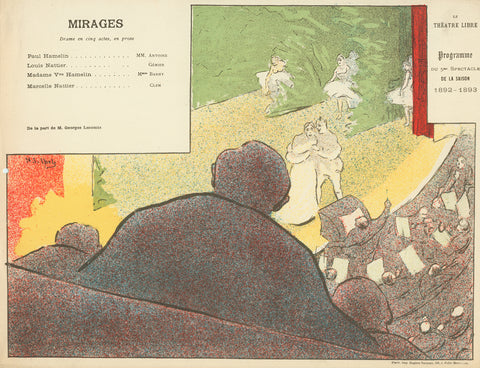
During the heydays of the Théâtre Libre Henri-Gabriel Ibels (1867-1936) parlayed his way into the commission of a lifetime. He convinced André Antoine to let him illustrate all the programs of the 1892-1893 season: all eight of them! This coup was major for the artist, who recalled years later how “… I want to illustrate the programs …Six months later I was no longer an unknown.” To the despair of some theatergoers these programs were not visually related to the plays being performed. The compositions, which are all illustrated below, were meant to be visually exciting, presenting very bright colors for the time. In these 8 lithographs Ibels shows both simple folks and intelligentsia. He showed circus performers, soldiers, workers in a bar, coal miners and men pulling a barge to the dock. But he also depicted bourgeois reading the paper, as well as beach and theater goers. The influence of Japanese color woodcuts is felt in varying degrees in each of these compositions. In all, however, his use of spatter to create texture and grain can be found. Often various colors of spatter are printed on top of one another, so as to create unexpected color mixtures.
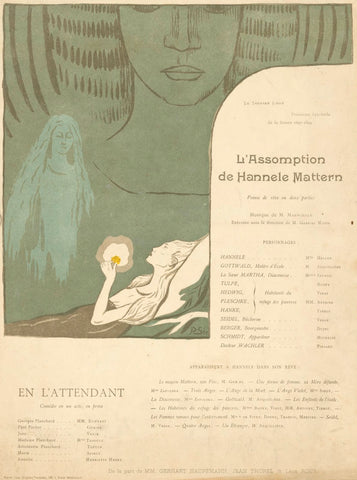
Paul Sérusier: L’Assomption du Hannele Mattern
These programs may have irked by being unrelated to the performances, but they were nonetheless liked by many patrons for their innovative qualities. Some Théâtre Libre programs, which to this day are not as well liked, such as Paul Sérusier’s L’Assomption du Hannele Mattern & En Attendant, are scarce. One can wait years to see an impression of this one come to market. However, Ibels’ programs, while increasingly scarce, do come up with a varying degree of regularity. This supposes that patrons kept these programs safely; probably because they liked them. It has to be said that fine art lithography was still rather novel in 1892. Before then, color lithography was a media used for low brow printing of posters, newsprint, ephemera… Only in 1889 did artists such as Henri de Toulouse-Lautrec and René Georges Hermann-Paul start to elevate the technique to a fine art media. It can therefore be assumed that patrons, whose appetite had been wet with beautiful compositions such as George Auriol’s Ménages d’Artistes in 1890, were ready to be impressed by the programs created by Ibels.
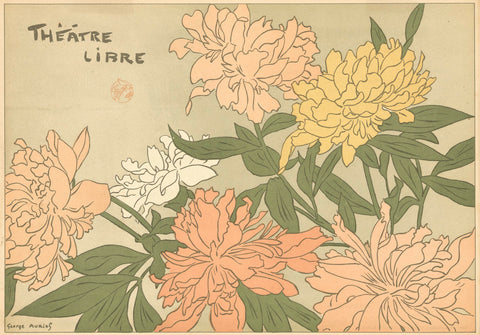
George Auriol: Ménages d’Artistes
A final fact also confirms that these Ibels programs were hugely successful: they were reprinted! While nearly all other Théâtre Libre programs are only found in their original condition, in the case of Henri-Gabriel Ibels’, they were all transferred to other lithographic stones (or possibly to zinc plates), they were partially reworked, and letters (texts and titles) were removed. These impressions are often referred to as being “before letters”, as if they had been printed earlier and were somehow more valuable for that reason. This is most certainly not the case. It is far more probable that, in light of their success with the public, they were reissued in this format.
Very recently we were lucky enough to find a homogeneous set of all eight Théâtre Libre programs by Henri-Gabriel Ibels. They have already found a new home, but this seemed to us an opportunity to highlight these wonderful works; all are illustrated and cataloged below. At some time in future we will also have to make a fully illustrated list of all Théâtre Libre programs available on this blog. That’s for some other time. As I type this, our project for a fully illustrated Estampe Originale catalog is only one third finished. We will have to complete this task first!
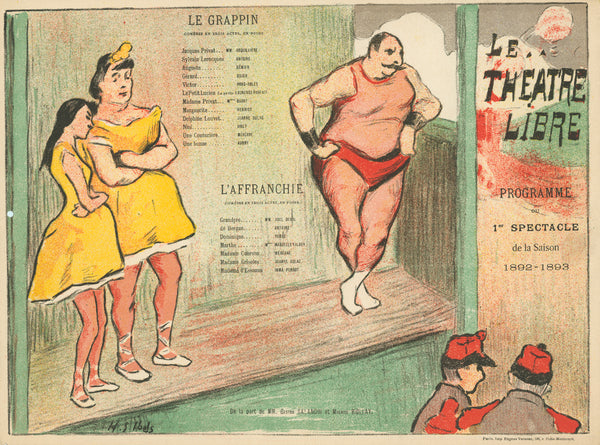
Henri-Gabriel IBELS (1867 - 1936)
Le Grappin & L’Affranchie
The Grapnel & The Emancipated (English titles)
Color lithograph printed card stock wove paper, 1892.
References: Eckert Boyer 30 (plate 12, pg. 48).
Program for the November 3rd, 1892 performance at the Théatre Libre.
The first of Ibels’ eight programs for this avant-garde theater.
Image size: 9 ⅜ x 12 ¾ inches.
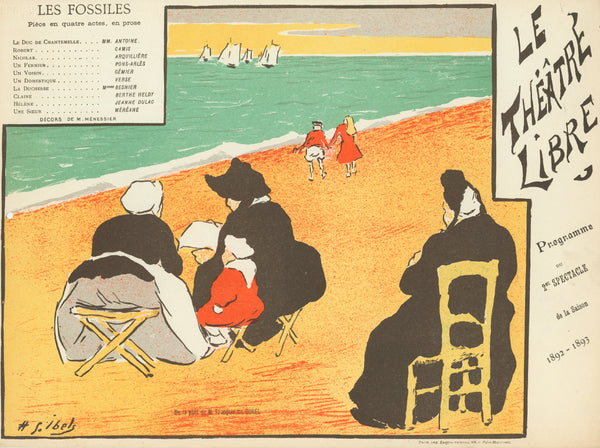
Henri-Gabriel IBELS (1867 - 1936)
Les Fossils
The Fossils (English title)
Color lithograph printed card stock wove paper, 1893.
References: Eckert Boyer 32 (plate 14, pg. 51).
Program for the November 29th, 1892 performance at the Théatre Libre.
The second of Ibels’ eight programs for this avant-garde theater.
Image size: 9 ⅜ x 12 ⅝ inches.
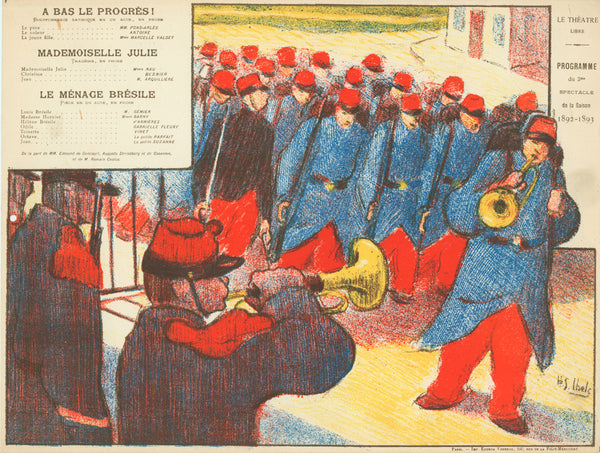
Henri-Gabriel IBELS (1867 - 1936)
A Bas le Progrès, Mademoiselle Julie & Le Ménage Brésile
Down with Progress, Miss Julie, The Brasil Household (English titles)
Color lithograph printed card stock wove paper, 1893.
References: Eckert Boyer 33 (plate 15, pg. 52).
Program for the January 16th, 1893 performance at the Théatre Libre.
The third of Ibels’ eight programs for this avant-garde theater.
Image size: 9 ½ x 12 ⅝ inches.
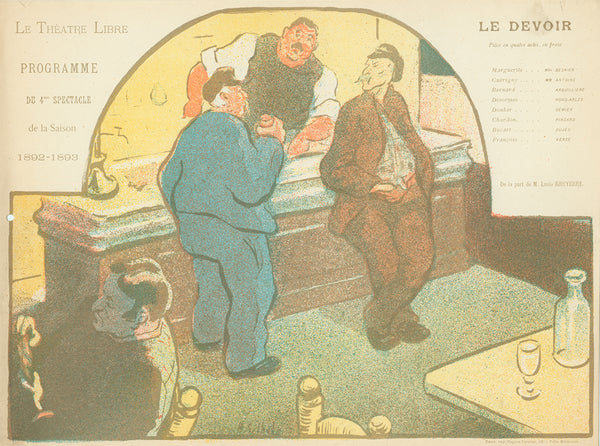
Henri-Gabriel IBELS (1867 - 1936)
Le Devoir
Duty (English title)
Color lithograph printed card stock wove paper, 1893.
References: Eckert Boyer 35 (plate 17, pg. 54).
Program for the February 15th, 1893 performance at the Théatre Libre.
The fourth of Ibels’ eight programs for this avant-garde theater.
Image size: 9 ½ x 12 ½ inches.

Henri-Gabriel IBELS (1867 - 1936)
Mirages
Color lithograph printed card stock wove paper, 1893.
References: Eckert Boyer 37 (plate 18, pg. 56).
Program for the March 27th, 1893 performance at the Théatre Libre.
The fifth of Ibels’ eight programs for this avant-garde theater.
Image size: 9 ⅜ x 12 ⅜ inches.

Henri-Gabriel IBELS (1867 - 1936)
Boubouroche & Valet de Coeur
Boubouroche & Jack of Hearts (English titles)
Color lithograph printed card stock wove paper, 1893.
References: Eckert Boyer 39 (plate 20, pg. 58).
Program for the April 27th, 1893 performance at the Théatre Libre.
The sixth of Ibels’ eight programs for this avant-garde theater.
Image size: 9 ½ x 12 ⅝ inches.

Henri-Gabriel IBELS (1867 - 1936)
Les Tisserands
The Weavers (English title)
Color lithograph printed card stock wove paper, 1893.
References: Eckert Boyer 41 (plate 22, pg. 60).
Program for the May 29th, 1893 performance at the Théatre Libre.
The seventh of Ibels’ eight programs for this avant-garde theater.
Image size: 9 ⅜ x 12 ½ inches.
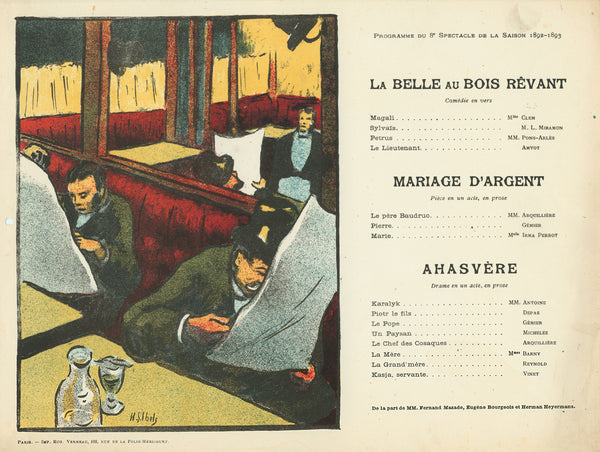
Henri-Gabriel IBELS (1867 - 1936)
La Belle au Bois Rêvant, Mariage d’Argent & Ahasvère
Dreaming Beauty, Moneyed (or Silver) Mariage & Ahasuerus (English titles)
Color lithograph printed card stock wove paper, 1893.
References: Eckert Boyer 42 (plate 23, pg. 63).
Program for the June 12th, 1893 performance at the Théatre Libre.
The final of Ibels’ eight programs for this avant-garde theater.
Image size: 9 ⅜ x 12 ½ inches.
